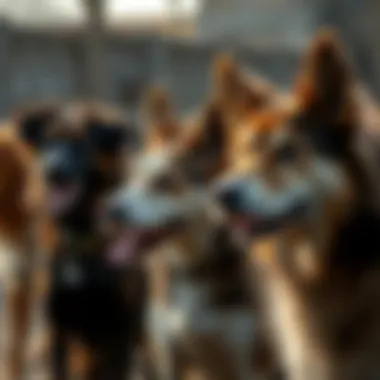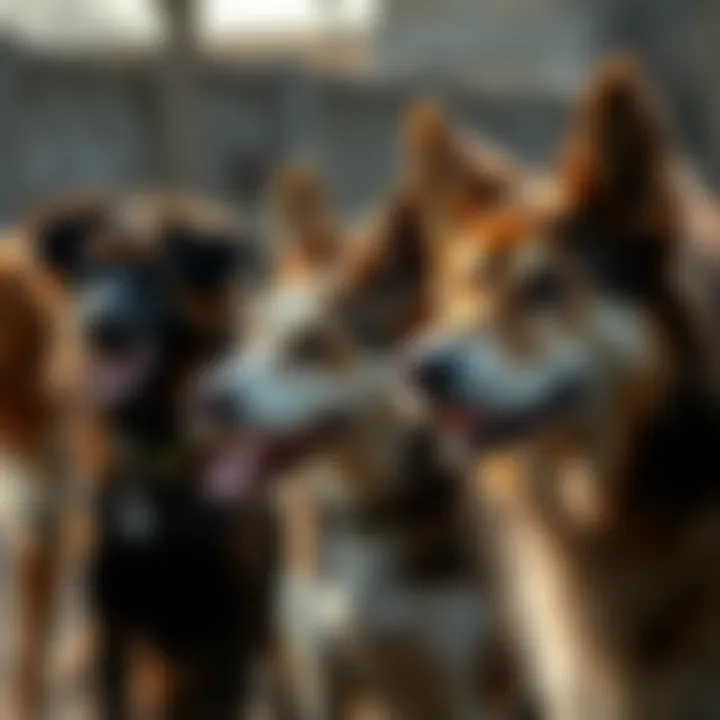Understanding the Heat Cycle in Dogs: Duration and Implications


Intro
Understanding a dog's heat cycle is crucial not just for prospective breeders, but also for pet owners who wish to provide the best care possible during this natural yet often misunderstood phase. When a female dog, or a bitch, enters her heat cycle, it indicates her readiness to mate, signaling a number of biological changes that are vital for reproduction. This article delves into the intricate world of the heat cycle, detailing its duration and the significant implications for health, behavior, and management strategies.
Throughout this piece, we will explore the various stages of the heat cycle, the observable changes in behavior and physiology, and how these transitions vary among different breeds. Enhanced comprehension of this topic equips pet owners with the necessary tools for responsible oversight, ensuring the well-being of their beloved companions during this period. With relevant research and practical advice woven into the narrative, both seasoned veterinarians and first-time dog owners will find valuable insights that can shape their understanding and approach to canine reproduction.
Join us as we navigate the fascinating intricacies of the heat cycle in dogs.
Intro to the Canine Heat Cycle
When it comes to understanding our canine companions, one aspect that often gets overlooked is the heat cycle. This natural process plays a crucial role in the reproductive health of female dogs and can significantly impact their behavior and overall well-being. Not only is it essential for those who are breeding dogs, but it also helps pet owners manage their pets during these phases, ensuring the comfort and health of their furry friends.
Defining Heat in Dogs
The term "heat" refers to the estrous cycle in female dogs, which is distinct from menstruation in humans. Unlike a menstrual cycle, which involves shedding the uterine lining, the heat cycle prepares the body for potential pregnancy. A female dog may experience heat as early as six months of age, depending on her breed and individual factors. The cycle occurs approximately every six months, although this can vary.
During heat, a dog exhibits certain physical signs, such as swelling of the vulva and a bloody discharge. Understanding these signs is essential for pet owners, as they indicate a time of increased vulnerability and potential for mating.
Importance of Understanding the Heat Cycle
Understanding the heat cycle is not just academic knowledge; it's practical and crucial for every pet owner. There are several reasons why this understanding is vital:
- Behavioral Awareness: Female dogs may show altered behaviors during their heat cycle. Knowing what to expect can help owners navigate these changes more effectively.
- Reproductive Health: Recognizing when a dog is in heat is key for responsible breeding practices. It allows for proper timing when considering breeding and preparing for any upcoming litters.
- Health Considerations: Some health issues can arise during the heat cycle. Awareness can lead to quicker veterinary care when necessary.
Knowing the ins and outs of your dog's heat cycle not only enhances your ability to respond to her needs but also strengthens your bond with her. By being well-informed, you can provide the best care possible, which is rewarding for both you and your pet.
Understanding the heat cycle in dogs is essential for promoting their well-being and managing their behavior effectively.
In the following sections, we will break down the phases of the heat cycle in detail and highlight what to watch for during each stage. This comprehensive examination will offer valuable insights whether you're a seasoned breeder or a first-time owner trying to get a handle on your dog's needs.
Phases of the Heat Cycle
Understanding the heat cycle in dogs is essential not just for the sake of breeding, but also for general dog ownership and care. Each phase has unique physiological changes that impact the dog's behavior, health, and well-being. Recognizing these phases will help pet owners provide appropriate care, manage behavioral changes, and address any health concerns.
Proestrus: Signs and Duration
Proestrus marks the beginning of the heat cycle, usually lasting around 7 to 10 days. During this phase, certain behavioral changes become apparent. For instance, you might notice a female dog becoming more affectionate or, conversely, irritable. She may also exhibit a certain restlessness, pacing around and showing eagerness for attention or companionship.
Physical signs include swelling of the vulva and the presence of blood-tinged discharge, which can alarm some owners if they're unaware. The scent released during this stage can attract male dogs from quite a distance. Because this phase can vary from dog to dog, keeping a close eye can help you gauge when she's ready for the next step in her cycle.
"Noticing the signs in the Proestrus phase can prevent surprises later on and help manage the dog's environment."
Estrus: The Fertile Stage
Estrus is the active breeding phase, often lasting from 5 to 9 days. This is when a female dog is most fertile, presenting opportunities for mating. Here, behavioral tendencies shift; many owners report that their females become more playful, flirtatious, and even slightly more affectionate than usual. It’s critical to be vigilant during this time, as male dogs can often be drawn in by her pheromones.
Physically, the vulva continues to be swollen but may appear softer. Discharge might lighten in color, ranging from a pink to clear appearance. Understanding this phase is key, especially for those considering breeding, as timing can make all the difference in ensuring successful mating.
Diestrus: Post-Estrus Changes
Once the breeding phase is done, dogs enter diestrus. This period generally lasts about 60 to 90 days, even in non-pregnant females. During diestrus, the body prepares for potential pregnancy, and various hormonal changes can bring about different behaviors.
For a female not bred, she may show a calm demeanor, returning to her normal routine. However, on the other hand, some dogs may experience false pregnancies, where they exhibit nesting behaviors or even lactation without the presence of actual puppies. Knowing this can help reduce confusion and anxiety for both the dog and the owner.


Anestrus: The Resting Phase
Anestrus is the resting phase that follows diestrus, lasting anywhere from 3 to 5 months. Here, reproductive activity comes to a halt. This phase is where the dog’s body recuperates and prepares for the next heat cycle. During anestrus, there are typically no visible signs of heat, and behavioral changes are minimal.
It's vital to understand this phase as it allows the owner to provide appropriate care. Some might think their dog’s health is failing if noticeable energy and playfulness decrease, but this is normal. Ensuring a balanced diet and regular exercise during this time maintains well-being, setting the stage for the next cycle.
Overall, recognizing each phase in the heat cycle can greatly enhance the relationship between the owner and their dog, fostering an environment that promotes health and happiness during these natural biological changes.
Duration of the Heat Cycle
Understanding the duration of the heat cycle in dogs is crucial for pet owners, veterinarians, and breeders alike. This phase of a female dog’s reproductive cycle has implications that extend beyond mere biology. Knowing how long this cycle lasts not only affects breeding plans but also impacts health monitoring and behavioral management. Familiarity with the timeline allows dog owners to anticipate changes and make informed decisions regarding care and breeding practices. A well-timed approach is essential in ensuring the well-being of both the mother and her potential puppies.
Average Length of Time in Heat
Generally, a dog will go into heat approximately every six months, but the duration can differ widely. The average heat cycle lasts about two to three weeks, broken down into specific phases. The key phases include proestrus, estrus, and diestrus. Each phase has distinct characteristics and signs that can help owners gauge where their dog is in her cycle.
- Proestrus lasts about 9 days and is marked by a swollen vulva and bloody discharge.
- Estrus, which is the actual mating phase, follows proestrus and typically lasts around 5 to 9 days. During this phase, the discharge might become lighter, indicating fertility.
- Finally, diestrus can last for about 60 days if the dog has mated, leading to pregnancy.
"Dogs cycle through heat periods that are about six months apart, but variations exist, so regular observation is vital."
Variations by Breed Size
It's important to note that the duration of the heat cycle can also vary significantly by breed size. Smaller dog breeds like Chihuahuas might have shorter cycles compared to larger breeds like Great Danes. Knowing this can help pet owners adjust their care strategies accordingly.
- Smaller Breeds: Dogs like Pomeranians or Yorkshire Terriers can go into heat as early as 6 to 8 months, and their cycles may be shorter.
- Medium Breeds: Breeds such as Beagles and Bulldogs often have a cycle duration that aligns closely with the average of about 6 months.
- Larger Breeds: For larger breeds like Rottweilers or Labrador Retrievers, the cycles can extend slightly longer, sometimes reaching several weeks.
Understanding these differences is vital. It aids in fostering a better environment for pets during sensitive periods and can inform when to schedule regular veterinary check-ups or discussions about spaying operations.
This period in a dog's life can bring challenges, but awareness and knowledge can lead to better management and improve the dog's quality of life.
Behavioral Changes During Heat
Understanding behavioral changes during the heat cycle is crucial for pet owners, breeders, and veterinarians. These changes can provide insights into a dog’s physical and emotional condition. Recognizing these shifts can aid in managing a dog's needs, maintaining household harmony, and ensuring the health of both the dog and any potential mates.
Being attuned to how a female dog behaves while in heat allows for informed decisions regarding care, training, and even breeding. This understanding holds implications not just for the animals involved but also for their human companions, fostering a nurturing environment that respects the natural rhythms of canine life.
Common Behavioral Indicators
During the heat cycle, female dogs exhibit several notable behaviors. Some common signs include:
- Increased Affection: Dogs may seek more attention and affection from their owners. This behavior can manifest as increased cuddling or playfulness.
- Marking Territory: A female dog in heat often exhibits heightened territorial behavior, including urinating more frequently to signal her availability to males.
- Restlessness: Many females become more restless and fidgety. They may pace around or seem unable to settle down easily, which can be puzzling for their owners.
- Increased Vocalization: Some dogs may become more vocal than usual, which might be confusing for those unused to this behavior.
- Changes in Appetite: While some dogs might lose their appetite, others may experience an increase in food cravings.
- Withdrawal: Conversely, some dogs may withdraw and seem less interactive or social. This could be due to discomfort or the overwhelming nature of physical changes.
Recognizing these signs can empower owners to provide the most suitable environment for their pets. It also plays a role in modifying behavior to help ease the dog through this phase.
Managing Behavioral Issues
Managing a dog's behavior during the heat cycle can present challenges. For many pet owners, understanding and addressing these changes with empathy and forethought is key. Here are several strategies:
- Provide Structure: Keeping a regular routine helps maintain a sense of normalcy for the dog. Regular feeding and walking times can instill stability amidst the hormonal fluctuations.
- Exercise: Engaging in regular exercise can help alleviate restlessness and behavioral issues. A good walk or play session may help tire the dog out and reduce anxiety.
- Distractions: Providing toys or puzzles can keep a dog mentally stimulated and less focused on her heat cycle.
- Create a Comfortable Space: Design a quiet and comfortable space where the dog can rest undisturbed.
- Crate Training: For some families, crate training an in-heat dog may provide a safe space to manage her behavior while preventing unwanted interactions with male dogs.
- Consult a Veterinarian: If behavioral changes seem excessively disruptive, seeking advice from a veterinarian can offer additional strategies, including potential medications that can ease anxiety.
Recognizing the complexities of a dog's emotional landscape during heat can foster a more harmonious living environment. Couples of dogs or interactions need careful consideration during this time to prevent unwanted breeding and ensure the well-being of the female dog.
Health Considerations for Dogs in Heat
The heat cycle can bring about various health considerations that every dog owner should keep in mind. As a female dog transitions through this cycle, she may encounter a number of physical and emotional challenges. Understanding these health implications is crucial not only for the well-being of the dog but also for ensuring responsible pet ownership. Recognizing potential health risks and knowing the right veterinary options can help keep your dog comfortable and healthy during this time.


Potential Health Risks
Increased blood flow and hormonal changes during the heat cycle can lead to several health risks for female dogs. Some of the key issues to watch for are:
- Pyometra: This is a serious condition that involves a bacterial infection in the uterus. It can happen after a heat cycle if hormones cause the uterus to thicken and create an environment for infection. Symptoms include excessive thirst, lethargy, and discharge.
- Mammary Tumors: The hormonal fluctuations can sometimes lead to the development of tumors in the mammary glands, particularly if the dog is not spayed. It’s important to monitor any changes in the mammary area.
- Infections: A female dog in heat may be more prone to urinary tract infections (UTIs), as the hormonal changes can affect her urinary tract health.
- Behavioral Issues: Increased anxiety or stress during this time can sometimes contribute to health problems. A stressed dog may show signs of excessive licking or chewing on herself, leading to potential skin infections or other issues.
Monitoring for signs of distress or unusual behavior is vital. If you suspect your dog is experiencing discomfort, consulting with your veterinarian early on could prevent serious health complications.
Veterinary Care Options
When it comes to ensuring the health of a female dog in heat, several veterinary care options can be explored:
- Regular Checkups: Scheduling a routine checkup before and during the heat cycle can help your vet assess her health and identify potential risks early on.
- Spaying: This is often discussed during a female dog’s first heat cycle. Spaying not only prevents unwanted pregnancy but also reduces the risk of certain health threats such as pyometra and mammary tumors later in life.
- Medications: If your dog is experiencing significant discomfort or is at risk for infections, a veterinarian may prescribe medications to alleviate symptoms or prevent infections.
- Diet Considerations: Providing a balanced diet during this time can support your dog’s overall health. Your vet might recommend dietary adjustments or supplements to help manage any hormonal fluctuations.
The heat cycle is a natural part of a female dog's life, but it does come with its challenges. Being vigilant and proactive can make a world of difference. As the saying goes, an ounce of prevention is worth a pound of cure. Keeping in close contact with your vet and being aware of your dog’s behavior and health can help manage this cycle more effectively.
For more information on canine health during the heat cycle, you might find these resources useful:
Breeding Considerations
Breeding considerations play a pivotal role in understanding the heat cycle in dogs. They encompass the timing and health checks essential for a successful mating process. Being well-informed about these factors allows pet owners and breeders to make educated decisions that can lead to healthier litters and prevent unforeseen complications. The consequences of these choices can ripple through the future of the canine population and the well-being of the individual dogs involved. It's not just about reproduction; it's about the overall health and happiness of the animals.
Timing for Optimal Breeding
Getting the timing right for breeding can be a matter of biology and keen observation. The estrus phase, where the female dog is fertile, usually occurs around day 11 to day 15 of her heat cycle. However, this can vary based on the individual dog and her breed. Knowing when to mate is critical. The key here is to monitor the female’s behavior and physical signs closely during the heat cycle.
Here are some indicators that the female is ready to breed:
- Behavioral Changes: She may show signs of increased affection or restlessness.
- Swelling of the Vulva: This is a clear signal that she is in the proestrus stage moving into estrus.
- Clear Discharge: The discharge can become clearer and more slippery as she nears peak fertility.
- Acceptance of Males: If she starts to show interest in male dogs, it is a good sign she is ready for breeding.
Using these cues, breeders should aim for mating during the estrus phase itself, which lasts approximately 5 to 9 days. Mates can be scheduled to coincide with peak fertility for the best chance of successful conception.
Health Screening for Breeding Dogs
Before engaging in breeding, both the male and female dogs should undergo comprehensive health screening. This is not just a formality but a safeguard against potential inherited health issues. Some important health checks include:
- Genetic Testing: Understanding predispositions to certain genetic conditions is vital.
- Physical Examination: A thorough check-up can identify any health issues that need attention before the breeding.
- Vaccination Status: Ensure that all vaccines are up to date to prevent any transmissible diseases.
- Reproductive Health: This includes checking the uterus and the overall reproductive system of the female to ensure she is fit for breeding.
By taking these precautions, breeders not only protect their investment but also contribute to the greater health of the breed. A responsible approach to breeding can significantly reduce health issues in future generations.
Remember: Proper planning in breeding ensures a healthier start for puppies, reduces strain on the mother, and supports ethical breeding practices.
For further reading, you can explore resources at American Kennel Club and Breed Health Certificate to get more guidance on breeding considerations.
Management Strategies During Heat
The management of a dog's heat cycle is quite crucial for pet owners. It's not just a matter of convenience; it impacts the overall well-being of the animal and their interactions with the environment. Effective management can mitigate behavioral issues that often arise during this time while ensuring the health of the female dog. Moreover, understanding how to handle these situations can also prevent unwanted pregnancies. That’s why it is important to equip oneself with practical strategies that cater to both the dog's needs and the owner's peace of mind.
Practical Tips for Pet Owners
Handling a female dog in heat requires a blend of preparation, understanding, and patience. Here are some practical tips that can smoothen this time:


- Create a Safe Space: It is necessary to set aside a designated area in your home where your dog can feel comfortable and secure. This space should be away from high-traffic areas, allowing her some quiet time away from distractions.
- Routine Walks: Maintain a regular walking schedule but opt for less crowded routes. It's also smart to keep your dog on a leash during walks; this helps to avoid encounters with male dogs that might be a distraction or cause stress.
- Supervise Interactions: Be cautious about introducing your dog to other pets. During this period, she may display different behaviors that could lead to misunderstandings or potential issues.
- Monitor Health: Keep an eye on physical changes. If you notice anything out of the ordinary, such as discharge that appears different or excessive lethargy, don't hesitate to consult your vet.
Implementing these strategies not only helps in managing the heat cycle but also strengthens the bond between pet and owner through understanding each other’s needs.
Use of Dog Diapers and Crates
For some owners, managing a dog in heat can feel like a juggling act. Dog diapers and crates become valuable tools to help navigate this tricky period.
- Dog Diapers: These can be a game changer for maintaining cleanliness in your home. They come in various sizes and styles, so selecting the right fit is essential. Not only do they protect your furnishings, but they also offer your pet a sense of comfort and maintain hygiene. Most dogs adapt quickly to them, especially if introduced gradually.
- Crates: On the other hand, using a crate can provide a secure environment for your dog when unsupervised. It helps control her movements around the house and keeps her from wandering off during this vulnerable period.
- When using a diaper:
- Ensure that it is breathable to avoid irritation.
- Check it regularly to replace as needed—better safe than sorry!
- Praise your dog when she wears them to create a positive association.
- Benefits of a crate:
- Provides a familiar and safe space your dog can retreat to.
- Helps prevent unwanted behaviors caused by stress or discomfort during heat.
- Limits exposure to male dogs if you have both genders in your household.
Using these tools effectively can alleviate some stress from both the owner and the dog, paving the way for a smoother experience during the heat cycle. As with any strategy, the key lies in patience and understanding to ensure the health and happiness of your beloved pet.
Post-Heat Cycle Considerations
Understanding what happens after a female dog goes through her heat cycle is essential for any pet owner, veterinarian, or animal care professional. This phase—often overlooked—has implications for both health and behavior. Knowing how to differentiate between normal recovery and potential issues can make a significant difference in the well-being of the dog.
Signs of Pregnancy versus False Pregnancy
The signs of pregnancy in dogs can mimic those of false pregnancy, leaving pet owners in a state of uncertainty. Pregnant dogs often show behavioral shifts, such as nesting or increased affection. Their appetite may change, typically increasing as the pregnancy progresses. You might notice physical signs like weight gain or swelling in the abdomen.
In contrast, a false pregnancy, known as pseudopregnancy, can exhibit similar symptoms but is caused by hormonal changes rather than conception. During this time, female dogs might display nesting behaviors, and may even lactate despite not being pregnant. The body reacts as if it carried a litter, but without the pups to show for it. Here’s a quick comparison of the two situations:
- Signs of Pregnancy:
- Signs of False Pregnancy:
- Increased appetite
- Weight gain
- Nesting behavior
- Swollen abdomen
- Visible fetal movement in late stages
- Increase in appetite, but not consistent
- Nesting behavior without actual puppies
- Potential lactation
- Swollen abdomen that doesn't last
If there’s ever doubt, a trip to the veterinarian can give clarity through simple testing or ultrasounds. This way, pet owners can take the necessary steps for care, whether waiting for puppies or dealing with pseudopregnancy.
What to Expect in the Following Cycle
After a heat cycle, particularly if it was marked by unusual behaviors or health issues, it's crucial to monitor your dog closely. Expect variations in the next cycle based on a few critical factors:
- Timing: Many dogs will follow a regular pattern, cycling every six to twelve months after their first heat, posing less uncertainty. But some variations can arise, so being observant is key.
- Behavioral Norms: Many pet owners report a change in their dog’s behavior after a heat cycle. A more irritable demeanor or heightened sensitivity to stimuli can emerge. This shift may be temporary, but awareness is helpful.
- Health Monitoring: Recurrent urinary infections or changes in her vulvar area can indicate complications. Neutering may be considered to alleviate these concerns in future cycles, hence the importance of discussing with a vet.
- Preparedness Tips:
- Keep a diary of your dog's cycles for tracking
- Note any significant behavioral changes
- Follow up regularly with your vet to stay ahead of any complications
Staying informed about the dynamics after a heat cycle contributes to proactive care and a happier, healthier dog. This knowledge is especially vital for veterinarians and families considering future breeding plans.
Ending
The conclusion of this article serves as a vital summation of the insights gathered on the heat cycle in dogs. Understanding this cycle is essential not only for pet owners, but also for those in professions related to animal care and breeding. Grasping the mechanics behind this biological phenomenon empowers individuals to make informed decisions about their dogs' health and well-being.
Recap of Key Points
To encapsulate the salient points discussed, it is crucial to remember the phases of the heat cycle: proestrus, estrus, diestrus, and anestrus. Each phase plays a unique role in the reproductive life of female dogs. The duration of these phases can vary significantly based on breed, size, and individual health. Furthermore, behavioral changes often accompany these phases, sometimes presenting challenges for owners.
"Recognizing the signs and understanding the implications of a dog's heat cycle can lead to better care and responsible pet ownership."
The health of a dog in heat is paramount. Owners are advised to note potential health risks while also not neglecting regular veterinary check-ups during this time. Moreover, understanding breeding considerations can make a considerable difference for those looking to breed their dogs. As professionals and pet owners navigate this intricate cycle, being equipped with practical care strategies can ease the process and enhance the overall experience.
Final Thoughts on Canine Reproduction
In summation, canine reproduction is a multifaceted subject that demands a thoughtful approach. The heat cycle, while a natural process, can bring forth various implications for dogs. Responsible pet ownership involves understanding not only the reproductive cycle but also its effects on the dog's behavior and health. By being proactive and informed, pet owners can foster a nurturing environment that supports their dogs through the complexities of this cycle. Addressing each phase with empathy and knowledge promotes not just successful breeding processes, but also the welfare of the dogs involved. Understanding this fundamental aspect of canine biology enriches relationships between dogs and their owners, paving the way for a healthier, happier companionship.







